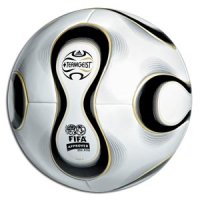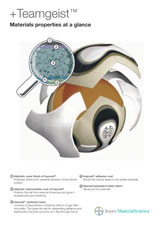 As the 2006 World Cup approaches, there has been a lot of talk about new technologies that might be used or experimented with. However, the one piece of technology nobody seems to pay attention to is also the most important. The Ball.
As the 2006 World Cup approaches, there has been a lot of talk about new technologies that might be used or experimented with. However, the one piece of technology nobody seems to pay attention to is also the most important. The Ball.
The only time the media has really written about it was when there was talk of using the chip embedded balls to detect when the ball had crossed the goal line. When FIFA decided that technology wasn’t ready, technology coverage moved on to the match video coverage, wireless technology being installed, etc. Don’t be fooled. When the players take the pitch in June, they won’t be using your average tournament ball.
adidas and Bayer have been hard at work designing the ball that will be used in the 2006 World Cup. Called ‘+Teamgeist’ (which translates to ‘Team spirit’), this ball is a radical departure from your average hexagon or pentagon paneled ball. Bayer just released a number of articles highlighting the work that had gone into the new ball.
(Hat-tip to Off the Crossbar for the links)
The "+Teamgeist(TM)" is just one percent away from being a perfect sphere. This makes it particularly accurate as it travels through the air. It is all down to the materials used to make it and the innovative construction. For the first time, the adidas specialists have thrown out the familiar five and six-sided sections to which we have been accustomed over the last few decades and replaced them with propeller-shaped panels. They have also reduced the total number of sections from 32 to 14. Fewer edges and more roundness also means fewer seams and corners in the outer skin so that when the players kick the ball, there is a greater chance that they will make contact with a smooth surface. This increases their chances of hitting the target.
SoccerBallWorld has a writeup on the new ball as well and highlights how the ball specifications meet and often far exceed the FIFA requirements:
Circumference: The FIFA Approved Standard: 68.5 cm – 69.5 cm. The adidas +Teamgeist: 69.0 cm – 69.25 cm
Diameter: FIFA Approved Standard: max. 1.5% difference The adidas +Teamgeist: max. 1.0% difference
Water Absorption: FIFA Approved Standard: no more than 10% weight increase. The adidas +Teamgeist: Water absorption: no more than 0,1 % weight increase
Weight: FIFA Approved Standard: Weight between 420 and 445 grams The adidas +Teamgeist: Weight between 441 and 444 grams
Shape and Size Retention: FIFA Approved Standard: 2,000 cycles at 50 km per hour. The adidas +Teamgeist: 3,500 cycles at 50 km per hour.
Rebound Test: FIFA Approved Standard: No more than 10 cm. The adidas +Teamgeist: No more than 2 cm.
Loss of Pressure: FIFA Approved Standard: Loss of pressure max. 20% The adidas +Teamgeist: Loss of pressure max. 11%.
 One of the most interesting things about the ball is the markedly different panel structure. Instead of the usual hexagon or pentagon shaped panels, the Teamgeist uses 8 large propeller shaped panels that fit between 6 bone or mask shaped strips (which in this case have all the logo printing on them) The marketing materials claim that this will vastly improve the accuracy of shots by reducing the number of seams. It also allows them to get much closer to a perfect sphere.
One of the most interesting things about the ball is the markedly different panel structure. Instead of the usual hexagon or pentagon shaped panels, the Teamgeist uses 8 large propeller shaped panels that fit between 6 bone or mask shaped strips (which in this case have all the logo printing on them) The marketing materials claim that this will vastly improve the accuracy of shots by reducing the number of seams. It also allows them to get much closer to a perfect sphere.
Besides the core makeup of the ball, Bayer is very happy about the new surface of the ball:
Special measures have been taken to protect the novel surface, which is partly responsible for the superior play properties of the +Teamgeistâ„¢: An aliphatic polyurethane (PU) topcoat formulated with raw materials from Bayer MaterialScience AG essentially places it and the printed design "under glass," making the cover extremely resistant to abrasion. Polyurethane products from Bayer MaterialScience are also responsible for several other outstanding properties of the +Teamgeistâ„¢.
"Our mission was to find a coating that can be applied evenly to the new, disparately shaped panels. The coating could not be sticky, and it had to ensure that the ball would retain its unique appearance for a long time," said Thomas Michaelis, an expert for textile coatings at the Coatings, Adhesives, Sealants Business Unit of Bayer MaterialScience. The coating technology developed by his team and used here satisfies all of these requirements. Whereas the topcoat of Impranil® ELH-A is primarily responsible for the abrasion resistance, the aliphatic intermediate coat with Impranil® HS 85 LN makes the ball very durable and extraordinarily elastic.
From a youth league perspective, I hope that some of the technology put into this ball will make its way down to the lower tiers of balls. The water resistance is nothing short of amazing. The ability of the surface to withstand abuse and scuffing would also be nice for tournament balls and game balls given to coaches each season. Don’t be fooled. The real deal is $130 US right now, while the imitation balls have the same printing, but are still normal hexagon/pentagon patch balls. Hopefully we’ll see these materials produced in enough volume to make them affordable for the rest of us!
Granted, much of this information is marketing speak and the companies could be overhyping their accomplishments. However, the specifications speak for themselves. Only time will tell if the players like it as much as adidas and Bayer hope they will. This is a drastic departure from normal ball construction and the two companies seem to have been able to merge drastic changes in both structure and materials to make a significant advancement in soccer ball technology.



 (1 votes, average: 4.00 out of 5)
(1 votes, average: 4.00 out of 5)

June 30th, 2006 at 12:59 am
Judging from the quality of some of the goals in the tounry thus far, I would say the ball has lived up to some of the pre tourny hype. Shots from the field have been amazing.
June 30th, 2006 at 8:35 am
It really has. Those 30 yd rockets have been impressive. I know a few fans have grumbled about many shots going WAY high, but I expect that is just something players will adjust too. They’ve only been playing with the new balls in training since January or so when it was released. So when they get rushed to get a shot off, it is often going sky high.
I’ve also noticed that for all the keeper grumbling about how it bobs in the air and is hard to stop, we’ve seen many impressive saves and the match scores haven’t been super high.